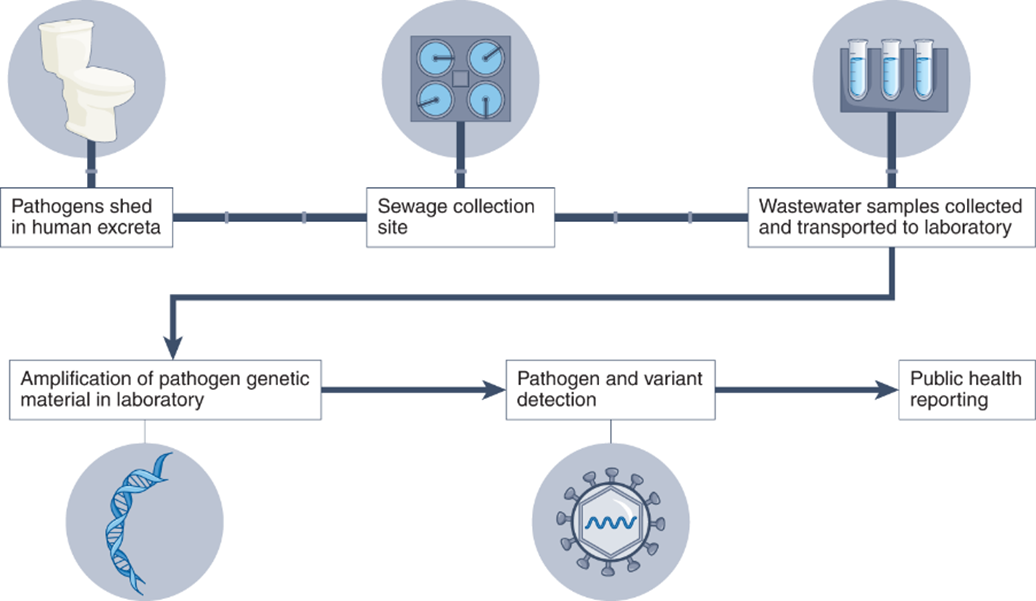What is Wastewater Surveillance?
Wastewater surveillance is the testing of wastewater (also referred to as sewage) to identify contaminants. Wastewater includes rainwater and water produced by the community from sources such as toilets, showers, and sinks. Wastewater may contain contaminants like pathogens, chemicals, and sludge. When water is flushed or drained from a building or home, or enters a storm drain, it flows through the community’s sanitary sewage system to a wastewater treatment plant where it is treated to remove contaminants. Geographic areas that feed into the same wastewater collection system are called sewersheds.
Wastewater surveillance is a useful tool for public health professionals to assess community health. Pathogens can enter the wastewater from the stool (poop) of infected people and can be detected and measured. Wastewater surveillance can complement other types of surveillance data, like clinical testing, to inform public health decision making.
The Division of Epidemiology - Disease Surveillance and Investigation coordinates with the School Health Nursing Program to monitor infectious diseases in District of Columbia schools. When a reportable communicable disease is confirmed or suspected among students, faculty, and staff members, a protocol is in place to monitor and minimize the spread of infectious diseases.
Advantages and Limitations of Wastewater Surveillance
-
Advantages:
- Can be an early warning sign that a pathogen is spreading in a community
- Shows if disease levels are increasing or decreasing (Trends are more important than individual data points.)
- Does not depend on clinical testing (e.g., people seeking tests, availability of tests, access to healthcare)
- Limitations:
- Data lacks clinical context.
- Cannot accurately determine the number of infected individuals in a community
- Cannot directly compare data across labs and states
- Does not capture homes on septic systems or facilities served by decentralized systems that treat their own waste
- Sewer sheds may cross county or state boundaries, potentially complicating data interpretation (for example, some DC sampling locations receive wastewater from parts of counties in Virginia or Maryland)
COVID-19 Wastewater Surveillance at DC Health
DC Health is participating in the Centers for Disease Control and Prevention’s (CDC) National Wastewater Surveillance System (NWSS) to implement surveillance of SARS-CoV-2 in wastewater. DC Health and other participating state, local, and territorial health departments report COVID-19 wastewater data to the CDC to expand understanding of COVID-19 and support public health needs. CDC makes the data available to the public on the CDC COVID Data Tracker, which is updated twice a week.
DC Health, partnered with utilities, collects wastewater samples from several sites across the district including DC public schools, DC charter schools, congregate facilities, and the Blue Plains wastewater treatment plant.
Surveillance of Blue Plains has been carried out by partnered utilities since July 2021 and additional sites were added in February 2023. Surveillance is conducted on a weekly basis. The Blue Plains wastewater treatment plant is the largest treatment plant in the DC region and the largest advanced treatment facility in the world. The Blue Plains facility processes wastewater from approximately 1.6 million people and accounts for approximately 48% of the region’s current wastewater capacity. Blue Plains serves the entire population of DC as well as parts of Maryland and Virginia.
Additional Resources
- National Wastewater Surveillance System (NWSS) | National Wastewater Surveillance System | CDC
- CDC COVID Data Tracker: Wastewater Surveillance



